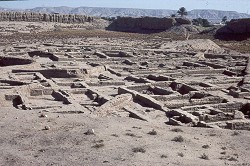
Elkab is located on the east bank of the Nile, about 95 kilometres south of Luxor. The ancient Egyptian name for the place is 'Nekheb'. Monuments have been found here from all periods of Egyptian history, from the Predynastic Period down to Coptic times. The twin towns of Elkab and Hierakonpolis, which lie close together on opposite sides of the Nile, together formed the capital city of Upper Egypt. The walled settlement of Elkab, dating from the Early Dynastic Period, was one of the first cities in Egypt, and extensive urban remains are preserved from later periods too. The cemetery contains a number of famous New Kingdom tombs, such as those of Paheri and Ahmose son of Ebana. In his autobiographical text, the latter tells how he helped to expel the Hyksos from Egypt. In addition to a temple for the god Thoth, a sanctuary to the goddess Nekhbet has also been found. The oldest parts of it date from the prehistoric period. Nekhbet ('She of Nekheb') was the tutelary goddess of the city. Her counterpart in Lower Egypt was Wadjet, the goddess of Buto. There, too, was a capital city which was originally two towns, Pe and Dep.